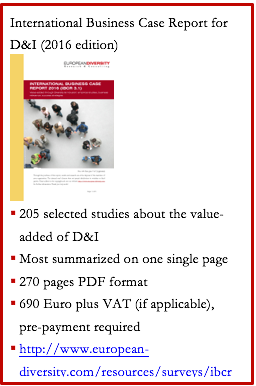
Stock Photo
Michael Stuber founded his company, European Diversity Research & Consulting, in 1997. Since then, he has written five books, dozens of articles and more than 100 columns about D&I. His broad and deep insight makes him a sought-after speaker and strategy consultant. Michael’s evidence-based approach has led to innovative models to train managers and experts on D&I.
We asked Michael why he thinks, based on his latest research, that the Business Case for D&I still needs updates and revisions, why he insists that the current Unconscious Bias training was not enough to move the needle and which global D&I trends he sees.
After 20 years of evidence-based D&I consulting, which issues or challenges do you still see that need to be addressed, if any?
Given the vast history of research and practices, the current challenge is to stay relevant for our audiences and, in doing so, regain momentum. We have seen some routine and hence fatigue creeping into parts of the D&I world.
What do you recommend should be done to address this?
In essence I see two main areas: First, we need to update our content, specifically the business case and the storyline we use to position D&I. Second, we must create new tools to work with our target groups. In all this, we should not forget that we operate at two speeds: One for new audiences where we almost start from scratch, establishing basic understanding for the breadth and scope of D&I, and another one for more advanced stakeholders that demand elaborate tools and a lot more sophisticated approaches to connect D&I with other topics in business and leadership.
Your first mention the Business Case. Your company publishes an updated report every two years. Since you established the business case for D&I in the 1990s, what changes or updates are required?
Early research into the benefits of managing diversity was quite specific, if not isolated, sometimes anecdotal and often focused on, for example, the performance of mixed teams. Research evolved to cover diversity of thought, functional diversity and today provides a much more comprehensive picture. Also, for IBCR, we carry out research in different parts of the world and we find large numbers of studies. Already for our first report, we saw a need to select and we therefore apply quality checks for validity, reliability and, if applicable, statistical bias. Hence, we obtain business case information that is generally relevant for organisations implementing D&I in different regions. At the same time, our research shows, that we are still in a learning phase on the business case. For example, today we have evidence that diversity in personal demographics is actually one key to bringing about the kind of different perspectives and approaches needed to fuel innovation or to improve customer centricity. Other recent research looked deeper into the mediating factors to add value through D&I. One study revealed the critical nature of an open-minded culture as a prerequisite to potentially leverage differences – for openness alone will not achieve this. Such results add evidence to our model describing D&I as a value-chain, called the Propelling Potential Principle. To summarize, today the body of research on the business case for D&I is more robust and differentiated than ever before.
What are some of the practical implications of this?
Research tells us that D&I should focus more on the corporate culture and specifically on the leadership culture. On paper, this has been on the D&I agenda for a while but many organizations do not dare to really shake up the culture that made them successful. This big task has not become easier in a fast-changing, globalised environment. Inclusive Leadership can be an important element in this, if we make it practical and connect it more clearly to existing leadership frameworks.
The other learning is that more programs should encompass aspects from the iceberg both from above and below the waterline. Strong foci on gender or diversity do not reflect the breadth of the business case nor realities and needs of many audiences.

IBCR
How does that concretely tie in with your concern to stay relevant, especially in a more and more complex, global context?
If we take the example of Unconscious Bias, wonderful tools to make people aware have been created and a wealth of illustrative approaches help to educate managers and employees. Many trainings and events, however, are not as strong in driving home the practical steps that should be taken to mitigate unwanted effects of biases. Our experience shows that a detailed review of different forms of biases should first establish a comprehensive understanding of the various forces that are at play. Concretely, we need to explain how other barriers to D&I that were discussed over the past decades, including micro-inequities, homosocial reproduction or stereotyping, tie in with what we today discuss under the headline of Unconscious Biases. Then, in each of the areas discussed, we need to look at very specific changes as direct and concrete responses to the insight gathered. In doing so, we create the traction needed to further move the needle.
Do we still need the business ‘head’ case when we successfully work on the heart case in the way you describe it?
Absolutely yes! The two pieces relate to different elements of a larger development or change process. The Unconscious Bias learning serves as an impetus for change. A major strength of our International Business Case Report is that people can find evidence for the return on investment they will reap for their practical efforts we ask them to put in to mitigate Unconscious Biases and strengthen Inclusive Leadership.
You have worked on four continents yourself and your IBCR research covers five. Where do you see the biggest challenges for companies as they navigate what diversity and inclusion means within different cultural contexts? How have these organizations addressed these issues so they do not become roadblocks?
Even in a globalised world, where things seem to be more and more similar, we must continue to be aware of changing contexts in which we operate – specifically when carving out messages, designing programmes and deploying tools. We should also be aware that the traditional, static cultural models have been replaced with more flexible, explorative approaches that accommodate hybrid cultural realities. Practically, quite a few differences have strong implications – and at times create the challenges you ask about – around what D&I can achieve in which region. For example:
In Europe it is acceptable and appropriate to look at biases that are embedded in processes or cultures; in the U.S. we have to be very careful in this area due to possible legal consequences. This means that being more explicit about systemic bias is recommended – or even needed – in Europe and provides a different lever for D&I.
Conversely, the well-established grass-root approaches for ERGs works very effectively in the U.S. while most assumptions and mechanisms will not create the same impact in Europe, let alone Asia.
Large corporations address these dynamics in different ways. Some make their frameworks more general and flexibly adaptable which then often lowers the strength or power. Others insist on what they define as global and implement it to the extent that it actually works in different regional environments. The best practice I see at this point in time is to identify the core of each element of your D&I framework and strategy that works universally and make that your global standard. In addition, be equally clear about factors that are flexible and that should be adapted and defined locally. This can be applied to the two examples I mentioned before: For ERGs, companies have already started to establish general charters as a foundation. However, many were either too specific or too general. Regarding the root cause analysis, we should define a level to which they must be carried out – everywhere in the world – and allow operating entities to tailor additional steps to the local context.
This sounds like ‘next practices’ for some organisations. What are some other new approaches you have seen organizations utilize to significantly move the needle on diversity and inclusion?
For me, one of the great trends is that initiatives have become more individually tailored and hence the landscape of D&I practices today is more diverse than what it was ten years ago. In my latest book about D&I, I was able to include almost 300 practices from 200 organisations. Here, I would like to mention two ‘next practices’ that relate to the learnings from the 2016 Business Case report mentioned before:
Companies are involving their general workforces to a wider extent in driving D&I. Large-scale dialogue sessions, for example, create a new quality of ownership and engagement. The use of social media supports this approach in an effective way.
Many are struggling with this, but I am convinced that we will have to let go of target-group specific initiatives, e.g. development programmes for women or, a recent example from Europe, specific training for men. We also need to rethink the extent to which we delegate D&I work to ERGs – even when they are inclusive in nature. A focus on target groups was required for a long time and it has made D&I tangible for many. Today, every form of segregation leads to cynicism or even backlash – even when it’s designed to compensate gaps from the past. Making D&I a practical form of applying company values or leadership principles is a promising new approach that we follow. Individual learning through self-tutoring or experiential learning in peer-groups are interesting forms of making his happen.
Overall, our D&I work will remain interesting and challenging. I guess we as D&I experts also need to apply one of the recommendations we give our audiences in so-called mono-cultures: We have to unlearn some of the things that made us successful in the past and embark on a paradigm shift for D&I in some areas. At the same time, we need to be bold and strong in showing the positive of our work.
Learn more about European Diversity Research & Consulting and Michael Stuber’s work:

